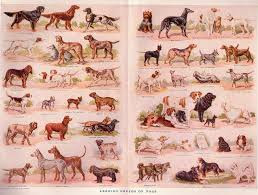Dogs

- New Research Explains Why Dogs Aren't Wolves
By Linda Cole I admire the spirit of wolves, an animal who has found the world to be a hostile place, even though man has embraced a species that was born from them. There are similarities between dogs and wolves, but dogs are not wolves. The reason why...
- Are All Dogs Descendants Of Wolves?
By Linda Cole Through responsible breeding and centuries of domestication, dogs are certainly man's best friend. But how much of their ancestral instincts have dogs maintained even with continued breeding that has calmed ancient instincts? I sometimes...
- Evolution Of Dogs
Dogs are regarded to be one of the oldest friends of men and they have been revered in many civilizations. Right from Egyptians to Greeks, everywhere dogs have been held with high regards for their faithfulness and intelligence. The Greek philosopher...
- Learn About A Dying Species - Facts About Wolves
When man was young on the Earth, millions of wolves roamed world wide. Today, due to centuries of hunting for sport, be it legal or illegal, there are little more than 300,000 wolves left in the world. Wolves are the largest of the canine breed and are...
- Chihuahua Mixed Breeds
The chihuahua is the smallest and probably the cutest dog breed, which every dog owner would love to own one. Characteristic chihuahua facts that make it a favorable pet dog are its small size, cute look, graceful and intelligent nature. In appreciation...
Dogs
The History of Dog Breeding

Humans have maintained populations of useful animals around their places of habitat since pre-historic times. Over these millennia, domesticated dogs have developed into distinct types, or groups, such as livestock guardian dogs, hunting dogs, and sighthounds. Artificial selection in dog breeding has influenced behavior, shape, and size of dogs.
Some researchers believe that the evolution of dogs from wolves is an example of neoteny or paedomorphism selection, that results in aretention of juvenile physical characteristics. Compared to wolves, many adult dog breeds retain such juvenile characteristics as soft fuzzy fur, round torsos, large heads and eyes, ears that hang down rather than stand erect, etc.; characteristics which are shared by most juvenile mammals, and therefore generally elicit some degree of protective and nurturing behavior cross-species from most adult mammals, including humans, who term such characteristics "cute" or "appealing". It has been seen that these traits can even prompt an adult female wolf to act more defensively of dog puppies than of wolf puppies. The example of canine neoteny goes even further, in that the various dog breeds are differently neotenized according to the type of behavior that was selected. Other researchers believe that because this comparison is based on the gray wolf, which is not the ancestor of the dog, that this comparison is invalid. Further research indicates that the concept of neoteny as a means of distinguishing dogs from wolves is baseless.
To maintain these distinctions, humans have intentionally mated dogs with certain characteristics to encourage those characteristics in the offspring. Through this process, hundreds of dog breeds have been developed. Initially, the ownership of working and, later, purebred dogs, was a privilege of the wealthy. Nowadays, many people can afford to buy a dog. Some breeders chose to breed purebred dogs, while some prefer the birth of a litter of puppies to a dog registry. It has been concluded that "findings imply that when selective breeding was done by humans, it squashed the snouts of certain dog breeds, it also morphed their brains" (Scientific American, 2010). Breeders have to abide by the rules of the specific organization to participate in its breed maintenance and development programs. The rules may apply to the health of the dogs, such as joint x-rays, hip certifications, and eye examinations; to working qualities, such as passing a special test or achieving at a trial; to general conformation, such as evaluation of a dog by a breed expert.
- New Research Explains Why Dogs Aren't Wolves
By Linda Cole I admire the spirit of wolves, an animal who has found the world to be a hostile place, even though man has embraced a species that was born from them. There are similarities between dogs and wolves, but dogs are not wolves. The reason why...
- Are All Dogs Descendants Of Wolves?
By Linda Cole Through responsible breeding and centuries of domestication, dogs are certainly man's best friend. But how much of their ancestral instincts have dogs maintained even with continued breeding that has calmed ancient instincts? I sometimes...
- Evolution Of Dogs
Dogs are regarded to be one of the oldest friends of men and they have been revered in many civilizations. Right from Egyptians to Greeks, everywhere dogs have been held with high regards for their faithfulness and intelligence. The Greek philosopher...
- Learn About A Dying Species - Facts About Wolves
When man was young on the Earth, millions of wolves roamed world wide. Today, due to centuries of hunting for sport, be it legal or illegal, there are little more than 300,000 wolves left in the world. Wolves are the largest of the canine breed and are...
- Chihuahua Mixed Breeds
The chihuahua is the smallest and probably the cutest dog breed, which every dog owner would love to own one. Characteristic chihuahua facts that make it a favorable pet dog are its small size, cute look, graceful and intelligent nature. In appreciation...
